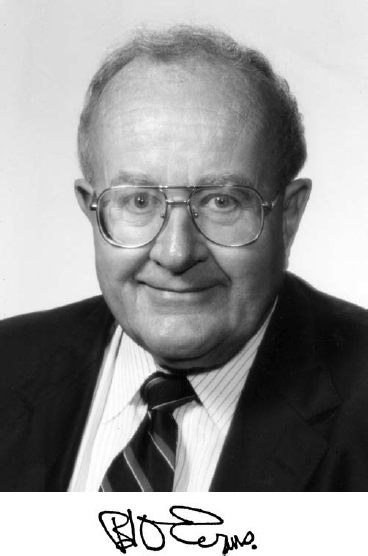1927–2004
Elected in 1970
“For personal and leadership contributions to the development of
computer technology and the design of computer systems.”
BY GENE M. AMDAHL
I first met Bob Evans in the summer of 1952 at the IBM laboratory in Poughkeepsie, New York. I had just arrived in Poughkeepsie in June as a new employee. Bob was associated with the same engineering group that I was entering, the group that had designed the IBM 701 computer. At that time most of the engineers were involved in supporting the field engineering activities, but Bob was working on the design and implementation of a graphical display system for the RAND Corporation. We became friends right away, and I was excited to see the engineering techniques he employed in the display system, which turned out to be very effective.
With many of the original planners of the IBM 701 assigned to the Sage System, I was assigned the task of planning the follow-on to the IBM 701—the IBM 704. I did the defining of the 704, including floating point and indexing. Bob Evans and the other 701 engineers did the logic designs involved in implementation of the changes. The market size estimation for the IBM 704 was 32, but the actual number sold was 140, so it was a remarkably profitable program! I was then asked to plan the IBM 709. At this time Bob Evans was assigned to the management of another project, so I lost track of him. I left IBM in late 1955, when the laboratory structure was changed and my project, Stretch (the IBM 7030), was altered, such that I no longer had control of the planning. Bob was subsequently involved as a project engineer in the Stretch I/O subsystem
design. From there he became the assistant to J. A. Haddad, director of advanced machine development, IBM Corporate Headquarters.
In 1956, Bob became the technical assistant to E. R. Piore, director of the newly formed IBM Research Division, Corporate Headquarters. Additionally, he was given a special assignment at the National Security Agency (NSA) to place a special computer in operation. In 1957 he was systems manager of Navy Development, Data Processing Division, where he led the development of special electronic computers for NSA, including SLED II, IBM’s first large-scale transistorized computer, and other classified projects. In 1959 he was systems manager of intermediate systems and developed the IBM 7070 in the Data Processing Division. And in the General Products Division he developed the IBM 1440/1401G/1410 machines.
In 1960, E. R. Piore hired me to join the IBM Research Division to head up the experimental machines department. This was to be for a minimum of four months to a maximum of seven months, at which time I was to be transferred to IBM’s San Jose laboratory. I had just started at IBM when Bob Evans requested me to meet with him at a budget session at Jug End in New York state. There, I sat through requests for funding hardware and software programs for two generations of three different computer families, for the second generation in each computer family was not quite compatible with the first generation.
In August of 1961, Bob requested me to be in charge of the design of the function and hardware of the members of what became the family of System 360. Bob was to be in charge of the corporate program.
I moved to Poughkeepsie into an area where Bob Evans and his family lived. Our son played with their son, a bit mischievously at times. Bob was vice president of development of the Data Systems Division, Poughkeepsie, an organization of more than 3,500 responsible for worldwide development of System 360 and all other midrange and large system products. Fred Brooks as corporate processor manager had responsibility for assuring adherence to spread committee uniformity rules.
After four years (not four to seven months), I accepted
a visiting professorship at Stanford, so IBM moved me to California as promised. IBM also made me a fellow in January 1965. At that time Bob was made president of the Federal Systems Division, in Gaithersburg, Maryland, concentrating on advanced technology and systems for aerospace, such as the National Aeronautics and Space Administration’s Gemini and Apollo programs.
In 1969, Bob was made president of the Systems Development Division. He was responsible for management of IBM’s principal computer product lines, including systems programming, and development and manufacturing of terminals and communications systems, point of sale, and banking subsystems.
In 1972, Bob Evans was elected a vice president of IBM. In 1974 he initiated the IBM-Comsat partnership, which became Satellite Business Systems. In 1977 he was made vice president of engineering, programming, and technology, to ensure the effectiveness of IBM’s wordwide technical activities.
On July 1, 1984, Bob took early retirement from IBM after 32 years, 9 months, to pursue other interests. He became general partner at Hambrecht and Quist Venture Partners, becoming managing partner in 1988. In 1995 he became president of Vanguard International Semiconductor Corporation.
Bob had so many other activities and positions that it is impossible to list them all here, but I must mention that he received the Edwin H. Armstrong Achievement Award in 1984 from the IEEE Communications Society, and in 1985 President Ronald Reagan presented him with the National Medal of Technology and Innovation for his work on IBM’s System 360.
I thought Bob had the most fantastic memory of any person I have known and felt that he related all previous experience to any new circumstance immediately! Bob was also a loyal and supportive friend and human being.
Bob is survived by his wife of 54 years, the former Maria Bowman; three sons, Robert, Douglas, and David; a daughter, Cathleen Licero, who works in marketing at IBM; and eight grandchildren.





